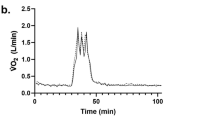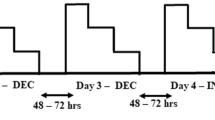Summary
The aims of this study were to determine the most appropriate duration for the measurement of the maximal accumulated O2 deficit (MAOD), which is analogous to the anaerobic capacity, to ascertain the effects of mass, fat free mass (FFM), leg volume (V leg) and lower body volume (V 1b) on anaerobic test performance, to examine the reproducibility for peak power output (\(\dot W_{{\text{peak}}} \)) or maximal anaerobic power using an air-braked cycle ergometer and to produce approximations for the percentages of aerobic and anaerobic metabolism during exercise of short duration but high intensity. A group of 12 endurance trained cyclists [mean age 25.1 (SD 4.6) years; mean body mass 73.43 (SD 7.12) kg; mean maximal oxygen consumption 5.12 (SD 0.35) l·min−1; mean body fat 12.5 (SD 4.1) %] accordingly performed four counterbalanced treatments of 45, 60, 75 and 90 s of maximal cycling on an air-braked ergometer. The mean O2 deficit of 3.52 l for the 45-s treatment was significantly less (P < 0.01) than those for the 60 (3.75 l), 75 (3.80 l) and 90-s (3.75 l) treatments. These data therefore indicate that in predominantly aerobically trained subjects the O2 deficit attains a plateau after 60 s of maximal cycling on an air-braked ergometer. Statistically significant interclass correlation coefficients (P<0.05) between the anthropometric variables (mass, FFM, V leg and V1b) and \(\dot W_{{\text{peak}}} \) or maximal anaerobic power (0.624–0.748) and MAOD (ml) or anaerobic capacity (0.666–0.772) furthermore would suggest the relevance of taking into account muscle mass during anaerobic tests. Intraclass correlation coefficients (0.935–0.946; all P<0.001) would indicate a high degree of reliability for the measurement of \(\dot W_{{\text{peak}}} \). The relative importance of anaerobic work decreased from 60% for the 45-s test to 40% for the 90-s one. Hence our study showed that both aerobic and anaerobic metabolism contributed significantly during all-out tests of 45–90 s duration.
Similar content being viewed by others
References
Åstrand PO, Rodahl K (1970) Textbook of work physiology. McGraw-Hill, New York, pp 295, 298
Åstrand PO, Hultman E, Juhlin-Dannfelt A, Reynolds G (1986) Disposal of lactate during and after strenuous exercise in humans. J Appl Physiol 61:338–343
Bangsbo J, Gollnick PD, Graham TE, Juel C, Kiens B, Mizuno M, Saltin B (1990) Anaerobic energy production and O2 deficit-debt relationship during exhaustive exercise in humans. J Physiol (Lond) 422:539–559
Bar-Or O, Dotan R, Inbar O (1977) A 30-sec all-out ergometric test: its reliability and validity for anaerobic capacity. Isr J Med Sci 13:326–327
Craig NP, Pyke FS, Norton KI (1989) Specificity of test duration when assessing the anaerobic lactacid capacity of high-performance track cyclists. Int J Sports Med 10:237–242
Daish CB (1972) The physics of ball games. English Universities Press, London, pp 121–123
Gastin PB (1992) Determination of anaerobic capacity during bicycle ergometer exercise. Thesis, Victoria University of Technology, Australia, pp 122–136
Gastin P, Lawson D, Hargreaves M, Carey M, Fairweather I (1991) Variable resistance loadings in anaerobic power testing. Int J Sports Med 12:513–518
Hermansen L, Medbø JI (1984) The relative significance of aerobic and anaerobic processes during maximal exercise of short duration. In: Marconnet P, Poortmans J, Hermansen L (eds) Physiological chemistry of training and detraining. Medicine and sport science, vol. XVII, Karger, Basel, pp 56–67
Linnarsson D, Karlsson J, Fagraeus L, Saltin B (1974) Muscle metabolites and oxygen deficit with exercise in hypoxia and hyperoxia. J Appl Physiol 36:399–402
Maxwell BF, Woods GF, Day L, Withers RT, Ilsley AH (1992) The dynamic calibration of cycle ergometers. Proc Aust Physiol Pharmacol 23:218 P
Medbø JI, Tabata I (1989) Relative importance of aerobic and anaerobic energy release during short-lasting exhausting bicycle exercise. J Appl Physiol 67:1881–1886
Medbø JI, Burgers S (1990) Effect of training on the anaerobic capacity. Med Sci Sports Exerc 22:501–507
Medbø JI, Mohn AC, Tabata I, Bahr R, Vaage O, Sejersted OM (1988) Anaerobic capacity determined by maximal accumulated O2 deficit. J Appl Physiol 64:50–60
Norusis MJ (1986) Advanced statistics SPSS/PC+ for the IBM PC/XT/AT. SPSS Incorporated, Chicago, p B-162
Sahlin K (1986) Metabolic changes limiting muscle performance, vol. VI. In: Saltin B (ed) Biochemistry of exercise. Human Kinetics, Champaign, Ill., pp 323–343
Saltin B (1990) Anaerobic capacity: past, present and prospective. In: Taylor AW, Gollnick PD, Green HJ, Ianuzzo CD, Noble EG, Metivier G, Sutton JR (eds) Biochemistry of exercise. vol. VII. Human Kinetics, Champaign, Ill., pp 387–412
Scott CB, Roby FB, Lohman TG, Bunt JC (1991) The maximally accumulated oxygen deficit as an indicator of anaerobic capacity. Med Sci Sports Exerc 23:618–624
Serresse O, Lortie G, Bouchard C, Boulay MR (1988) Estimation of the contribution of the various energy systems during maximal work of short duration. Int J Sports Med 9:456–460
Simoneau JA, Lortie G, Boulay MR, Bouchard C (1983) Tests of anaerobic alactacid and lactacid capacities: description and reliability. Can J Appl Sport Sci 8:266–270
Siri WE (1961) Body composition from fluid spaces and density: analysis of methods. In: Brozek J, Henschel A (eds) Techniques for measuring body composition. National Academy of Sciences National Research Council, Washington, DC, pp 223–244
Vandewalle H, Perils G, Monod H (1987) Standard anaerobic exercise tests. Sports Med 4:268–289
Wilmore JH, Costill DL (1974) Semiautomated systems approach to the assessment of oxygen uptake during exercise. J Appl Physiol 36:618–620
Withers RT, Whittingham NO, Norton KI, La Forgia J, Ellis MW, Crockett A (1987) Relative body fat and anthropometric prediction of body density of female athletes. Eur J Appl Physiol 56:169–180
Withers RT, Sherman WM, Clark DG, Esselbach PC, Nolan SR, Mackay MH, Brinkman M (1991) Muscle metabolism during 30, 60 and 90 s of maximal cycling on an air-braked ergometer. Eur J Appl Physiol 63:354–362
Author information
Authors and Affiliations
Rights and permissions
About this article
Cite this article
Withers, R.T., Van Der Ploeg, G. & Finn, J.P. Oxygen deficits incurred during 45, 60, 75 and 90-s maximal cycling on an air-braked ergometer. Europ. J. Appl. Physiol. 67, 185–191 (1993). https://doi.org/10.1007/BF00376665
Accepted:
Issue Date:
DOI: https://doi.org/10.1007/BF00376665




